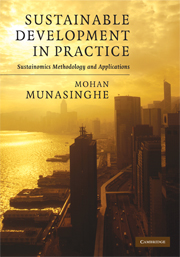Book contents
- Frontmatter
- Contents
- Foreword by James Gustave Speth
- Preface
- Part I Framework and fundamentals
- 1 Overview and summary
- 2 Sustainomics framework
- 3 Economics of the environment
- 4 Ecological and social aspects
- Part II Global and transnational applications
- Part III National and macroeconomic applications
- Part IV Sub-national sectoral and system applications
- Part V Project and local applications
- References
- Index
3 - Economics of the environment
Published online by Cambridge University Press: 05 August 2012
- Frontmatter
- Contents
- Foreword by James Gustave Speth
- Preface
- Part I Framework and fundamentals
- 1 Overview and summary
- 2 Sustainomics framework
- 3 Economics of the environment
- 4 Ecological and social aspects
- Part II Global and transnational applications
- Part III National and macroeconomic applications
- Part IV Sub-national sectoral and system applications
- Part V Project and local applications
- References
- Index
Summary
This chapter explores how economics relates to environmental (and related social) concerns. Section 3.1 outlines how environmental degradation is impeding economic development, while human activity is harming the environment. Sections 3.2 and 3.3 expand on economic cost–benefit analysis – a key element of SDA and the project cycle. Important details are explained, including economic decision criteria, efficiency and social shadow pricing, economic imperfections (market failures, policy distortions and institutional constraints), methods of measuring costs and benefits and qualitative considerations. Types of environmental assets and services, and practical techniques of valuing them, are described in Section 3.4. Section 3.5 outlines multicriteria analysis, which is useful for decision making when economic valuation is difficult. Key issues relating to discounting, risk and uncertainty are set out in Section 3.6. Finally, Section 3.7 explains links between economy-wide policies and environmental (and social) issues, as well as environmentally adjusted national accounts.
Human activities and the environment
Mankind's relationship with the environment has gone through several stages, starting with primitive times, in which human beings lived in a state of symbiosis with nature. Human interactions were primarily within the biotic sphere. This phase was followed by a period of increasing mastery over nature up to the industrial age, in which technology was used to manipulate physical laws governing the abiotic sphere. The outcome was the rapid material-intensive and often unsustainable growth patterns of the twentieth century, which damaged the natural-resource base.
- Type
- Chapter
- Information
- Sustainable Development in PracticeSustainomics Methodology and Applications, pp. 72 - 110Publisher: Cambridge University PressPrint publication year: 2009



